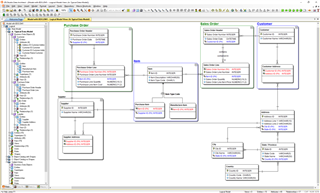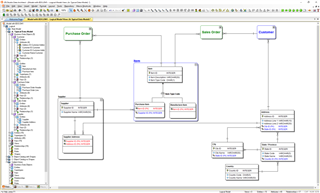Data modeling can be challenging for large enterprise architecture environments, but it provides the much-needed structure and context for an organization’s valuable data. As IDERA’s flagship data modeling and architecture family, the ER/Studio Data Architect data modeling tool has an extensive feature set that compares very favorably against the competition, and in addition to the usual data modeling and entity relationship diagramming capabilities that are common in the industry, ER/Studio offers a number of unique features that are not available from other vendors, including:
Sub-models – ER/Studio gives you the ability to easily organize extremely large and complex models by breaking out a portion of the entities into a separate structure. These maintain the relationships to the parent model while enabling you to focus on a specific section of the model in greater detail with less distraction from the rest of the model. Sub-models can be nested, and any changes made to objects (entities, attributes, relationships, tables, columns, foreign keys, procedures, functions, etc.) in the sub-model can optionally be automatically propagated to the associated main model and/or parent sub-model in the hierarchy.
Business Data Objects – You can improve organization and visibility further in your models by combining multiple related entities into BDOs to represent transactional or master data concepts, such as those defined in your conceptual models (for example, ‘Customer’ or ‘Product’). These will retain all the internal relationships while providing the ability to minimize the object for better model readability. When BDOs are minimized, the model view is simplified so that it can be shared with and explained to a wider audience.
Enterprise Data Dictionary – In ER/Studio, you can define an enterprise data dictionary with common data object model types (such as such as attachments, domains, rules and naming standards templates) that can be shared across both logical and physical models. When you add a metadata attachment to the data dictionary, it only needs to be defined once for the environment and can be applied to many different object types if necessary. Many of these metadata extensions are defined and created in order to support data governance. ER/Studio also has separate Data Security Information tags that are defined within the data dictionary.
Universal Mappings – The ability to link related objects within the same model file or across separate model files helps you with tracing repeated use of these entities. Universal Mappings have been implemented to support enterprise-level modeling in large organizations with many systems and overlapping data and processes. One example is linking the representations of the same real life business object that exist in different models, such as “employees” or “customers”. These mappings are retained and can be seen with Compare and Merge or Where Used operations.
Agile Change Management – As development workflows move at a faster pace, it is imperative to track the changes made to the data models and align them to the user stories or tasks created by agile methodologies. ER/Studio includes a Change Management log that captures the edits made to models and shows an audit trail that can link back to a development sprint and its tasks, to capture not only what changes are being made, but also why. This feature enables modelers to keep data models relevant with fast-changing databases and applications.
Native Support for NoSQL Platforms – While ER/Studio and other tools do offer some big data platform support through import and export bridges, only ER/Studio has incorporated native support for Hive and MongoDB platforms. Native support for big data can be defined as the ability to model big data constructs such as nested objects and object arrays typically found in big data stores with reverse and forward engineering. ER/Studio Data Architect can generate DDL for Hive and blank-sample JSON for MongoDB. For MongoDB, the model view includes a special “is contained in” notation extension for embedded objects and object arrays. Additionally, ER/Studio Enterprise Team Edition can reverse engineer from other NoSQL platforms (such as Amazon, Redshift, Cassandra, and Hadoop HDFS) using the integrated MetaWizard bridges.
Data Lineage Modeling – Understanding sources, targets, and transformations of enterprise data is a fundamental requirement for any organization to achieve viable data quality. ER/Studio Data Architect incorporates Data Lineage capability that gives data management professionals and business users essential insight to the extracts, transformations, and loads (ETL) of complex enterprise data. You can visually model the actual data flow, including stored procedures, and display the data inputs and outputs with mappings to and from the data stores. ER/Studio Enterprise Team Edition also includes import bridges to reverse engineer ETL data sources (such as Informatica PowerCenter, Microsoft SSIS, Talend, and Oracle ODI and OWB) into the modeling tool.
With all these great capabilities, ER/Studio can help you do more to manage your data architecture! Read more about why you should choose ER/Studio and how ER/Studio compares against ERwin Data Modeling tool. Try ER/Studio for free to see for yourself how powerful it is!



